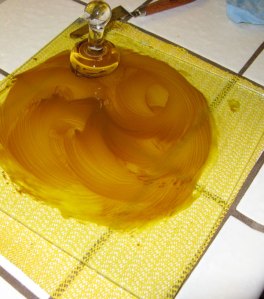For the past few years, I’ve been mulling paint, both watercolor and oil. Mulling is the process of dispersing pigment into a painting medium. This involves some elbow grease at times, since you’re breaking up larger glomerates of pigment into smaller glomerates. (Though mulling is often called grinding – slightly older terminology – you’re not actually grinding pigment particles into smaller pigment particles. With homemade pigments, though, there are some exceptions: for instance, there’s just only so fine I can grind eggshell white in a mortar and pestle; the fine grinding of that pigment happens with the muller.) Some pigments take longer and require more work, some less. The vermilion that I ground up recently was very quick and easy.
So: why mull paint, when there is so much in the way of ready-tubed paint to be had at the art supply store? Well, here are a few reasons one might want to mull their own paint:
One, to save money. Art supply companies often charge premium prices in what is, after all, a niche market. Understandable. But if one is willing to do a little work oneself, a noticeable amount of money can be saved for our hero, the starving artist. Remember the recession?
Two, to make a paint with a pigment that isn’t available on the market. If you’re a fan of de Laszlo and you’ve got a particular hankering to try painting with chrome orange, you’re just going to have to make that paint yourself, because it doesn’t exist in a tube at the store. Or, in my case, I wanted to mull up the pigments that I’ve made myself. (That’s actually what got me started mulling.)
Three, to produce paint with specific qualities that are not currently popular in tube paint. I personally like gritty, goopy paint, especially in earth colors (it’s just no good if I can’t make happy, chunky swirl sculptures on the palette), and it’s pretty easy to mull up a bit for the day and slap it onto the palette. I have found some paints on the market – Rublev in particular – that match the qualities I like, so I use a combination of home-mulled and bought paint.
(Related to this: some pigments alter their color depending on the grind. Vermilion, pictured at right, has been said to become brighter and more orange the finer it is ground. Copper pigments such as azurite and malachite become brighter and less intense – you could theoretically model an entire form using only different grinds of azurite!)
Oh, and Four, just for the experience. It can be quite satisfying to make your own paint, and even more satisfying to paint with it! – and it certainly educates one about materials. I recommend trying it!
The equipment you’ll need to start mulling your own paint: A muller and mulling slab (usually a tile of glass, but it could be stone as well); a paint spatula; and a rough material for roughening the glass surface of the slab. Maybe a gripping material like a cabinet liner, so the slab doesn’t slide all over the place while you’re mulling. Oh: and pigment and binder. How could I forget!
Next: Mulling and Tubing Your Own Paint!
Tags: eggshell white, mulling, oil paints, vermilion, watercolor, yellow lake



April 18, 2012 at 5:07 pm |
great post, as always! thank you for sharing your knowledge on this topic! i can’t wait for the next post! i still have not worked with my vermilion (but for now my hue is still better than my cad. red for skin tones)…. i’m very much looking forward to working with the real stuff though – just as soon as i find some time to do it! very interesting about the color/value change with vermilion, too! i’m glad you posted that before I tried working with mine! i got the same dry pigment that you mentioned in a previous post, and (dry at least) it does look very orange already. i have just assumed up to this point that it would look significantly more red once i mulled it with the oil. fascinating to know that that may not be the case if i go overboard! do you happen to know the scientific “why” behind the color change? you’ve piqued my curiosity once more! 🙂
April 21, 2012 at 6:04 pm |
Hey Chrissy!
The color shift with vermilion should actually happen during the grind, not while mulling – I wasn’t really clear about that. The mulling with this pigment from Kama Pigments was easy and quick, there shouldn’t be any danger of a shift. But it did seem to get darker and redder once mixed with oil, which surprised me, since it is a pretty opaque pigment.
Unfortunately, I don’t know the why of any of this – just what I’ve read! – L.
July 15, 2012 at 11:07 pm |
[…] II of Hand-mulling Paint is on the way too – promise! Like this:LikeBe the first to like […]
November 2, 2012 at 6:31 pm |
[…] Continued from Hand-mulling Paint, Part I. […]